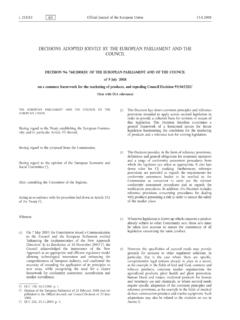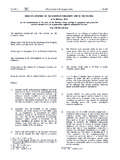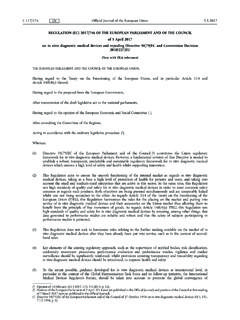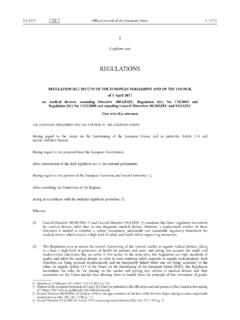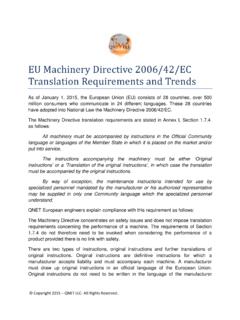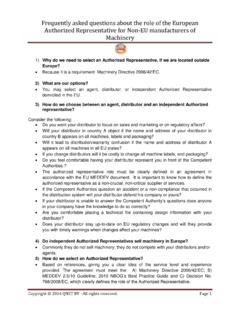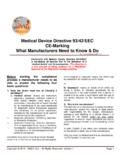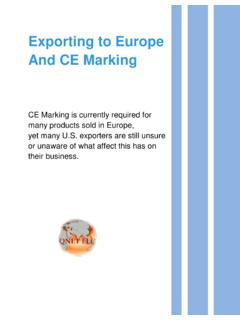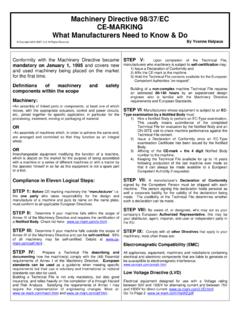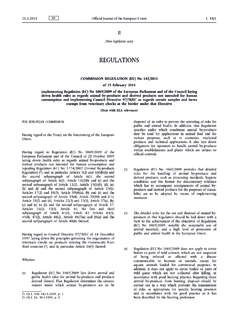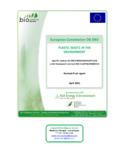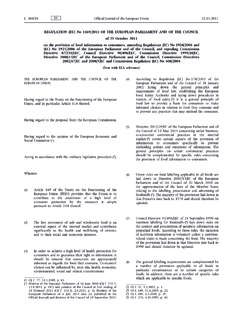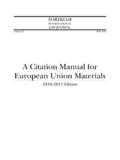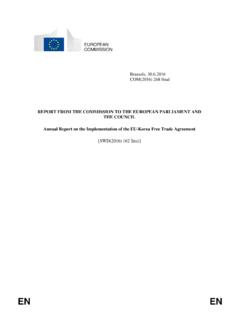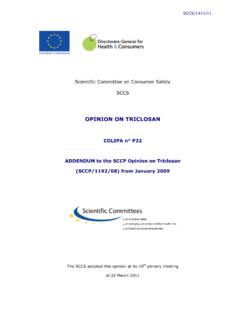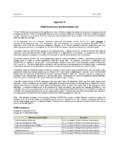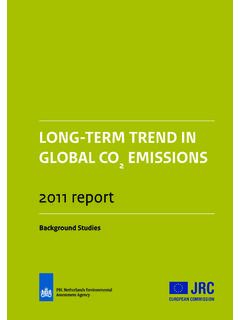Transcription of Directive 2011/65/EU of the European Parliament and of the ...
1 L 174/88 EN Official Journal of the European Union Directive 2011 /65/EU OF THE European Parliament AND OF THE COUNCIL. of 8 June 2011 . on the restriction of the use of certain hazardous substances in electrical and electronic equipment (recast). (Text with EEA relevance). THE European Parliament AND THE COUNCIL OF THE (4) Directive 2008/98/EC of the European Parliament and of European UNION, the Council of 19 November 2008 on waste (5) gives first priority to prevention in waste legislation. Prevention is defined, inter alia, as measures that reduce the content of Having regard to the Treaty on the Functioning of the European harmful substances in materials and products. Union, and in particular Article 114 thereof, (5) Council Resolution of 25 January 1988 on a Community Having regard to the proposal from the European Commission, action programme to combat environmental pollution by cadmium (6) invited the Commission to pursue without Having regard to the opinion of the European Economic and delay the development of specific measures for such a Social Committee (1), programme.
2 Human health also has to be protected and an overall strategy that in particular restricts the use of cadmium and stimulates research into substitutes should Having regard to the opinion of the Committee of Regions (2), therefore be implemented. The Resolution stresses that the use of cadmium should be limited to cases where suitable alternatives do not exist. Acting in accordance with the ordinary legislative procedure (3), (6) Regulation (EC) No 850/2004 of the European Whereas: Parliament and of the Council of 29 April 2004 on persistent organic pollutants (7) recalls that the objective of protecting the environment and human health from (1) A number of substantial changes are to be made to persistent organic pollutants cannot be sufficiently Directive 2002/95/EC of the European Parliament and achieved by the Member States, owing to the trans.
3 Of the Council of 27 January 2003 on the restriction boundary effects of those pollutants, and can therefore of the use of certain hazardous substances in electrical be better achieved at Union level. Pursuant to that Regu . and electronic equipment (4). In the interest of clarity, lation, releases of persistent organic pollutants, such as that Directive should be recast. dioxins and furans, which are unintentional by-products of industrial processes, should be identified and reduced as soon as possible with the ultimate aim of elimination, (2) The disparities between the laws or administrative where feasible. measures adopted by the Member States regarding the restriction of the use of hazardous substances in electrical and electronic equipment (EEE) could create barriers to trade and distort competition in the Union and may (7) The available evidence indicates that measures on the thereby have a direct impact on the establishment and collection, treatment, recycling and disposal of waste functioning of the internal market.
4 It therefore appears EEE as set out in Directive 2002/96/EC of the necessary to lay down rules in this field and to contribute European Parliament and of the Council of 27 January to the protection of human health and the environ 2003 on waste electrical and electronic equipment mentally sound recovery and disposal of waste EEE. (WEEE) (8) are necessary to reduce the waste management problems associated with the heavy metals and flame retardants concerned. In spite of those measures, (3) Directive 2002/95/EC provides that the Commission however, significant parts of waste EEE will continue to shall review the provisions of that Directive , in particular, be found in the current disposal routes inside or outside in order to include in its scope equipment which falls the Union.
5 Even if waste EEE were collected separately within certain categories and to study the need to adapt and submitted to recycling processes, its content of the list of restricted substances on the basis of scientific mercury, cadmium, lead, chromium VI, polybrominated progress, taking into account the precautionary principle, biphenyls (PBB) and polybrominated diphenyl ethers as endorsed by Council Resolution of 4 December 2000. (PBDE) would be likely to pose risks to health or the environment, especially when treated in less than optimal conditions. (1) OJ C 306, , p. 36. (2) OJ C 141, , p. 55. (3) Position of the European Parliament of 24 November 2010 (not yet (5 ) OJ L 312, , p. 3. published in the Official Journal) and decision of the Council of (6 ) OJ C 30, , p.
6 1. 27 May 2011 . (7 ) OJ L 158, , p. 7. (4) OJ L 37, , p. 19. (8 ) OJ L 37, , p. 24. EN Official Journal of the European Union L 174/89. (8) Taking into account technical and economic feasibility, (13) Directive 2009/125/EC of the European Parliament and including for small and medium sized enterprises (SMEs), of the Council of 21 October 2009 establishing a the most effective way of ensuring a significant reduction framework for the setting of ecodesign requirements of risks to health and the environment relating to those for energy-related products (2) enables specific ecodesign substances, in order to achieve the chosen level of requirements to be set for energy-related products which protection in the Union, is the substitution of those may also be covered by this Directive .
7 Directive substances in EEE by safe or safer materials. Restricting 2009/125/EC and the implementing measures adopted the use of those hazardous substances is likely to pursuant to it are without prejudice to Union waste enhance the possibilities and economic profitability of management legislation. recycling of waste EEE and decrease the negative impact on the health of workers in recycling plants. (14) This Directive should apply without prejudice to Union legislation on safety and health requirements and specific (9) The substances covered by this Directive are scientifically Union waste management legislation, in particular well researched and evaluated and have been subject to Directive 2006/66/EC of the European Parliament and different measures both at Union and at national level.
8 Of the Council of 6 September 2006 on batteries and accumulators and waste batteries and accumulators (3). and Regulation (EC) No 850/2004. (10) The measures provided for in this Directive should take into account existing international guidelines and recom . mendations and should be based on an assessment of available scientific and technical information. The (15) The technical development of EEE without heavy metals, measures are necessary to achieve the chosen level of PBDE and PBB should be taken into account. protection of human health and the environment, with due respect for the precautionary principle, and having regard to the risks which the absence of measures would be likely to create in the Union. The measures should be (16) As soon as scientific evidence is available, and taking into kept under review and, if necessary, adjusted to take account the precautionary principle, the restriction of account of available technical and scientific information.
9 Other hazardous substances, including any substances of The annexes to this Directive should be reviewed peri very small size or with a very small internal or surface odically to take into account, inter alia, Annexes XIV and structure (nanomaterials) which may be hazardous due to XVII to Regulation (EC) No 1907/2006 of the European properties relating to their size or structure, and their Parliament and of the Council of 18 December 2006 substitution by more environmentally friendly alter . concerning the Registration, Evaluation, Authorisation natives which ensure at least the same level of protection and Restriction of Chemicals (REACH) and establishing of consumers should be examined. To this end, the a European Chemicals Agency (1).
10 In particular, the risks review and amendment of the list of restricted substances to human health and the environment arising from the in Annex II should be coherent, maximise synergies with, use of Hexabromocyclododecane (HBCDD), Bis (2- and reflect the complementary nature of the work carried ethylhexyl) phthalate (DEHP), Butyl benzyl phthalate out under other Union legislation, and in particular (BBP) and Dibutyl phthalate (DBP) should be considered under Regulation (EC) No 1907/2006 while ensuring as a priority. With a view to further restrictions of the mutually independent operation of this Directive substances, the Commission should re-investigate the and that Regulation. Consultation with the relevant stake . substances that were subject to previous assessments, in holders should be carried out and specific account should accordance with the new criteria set out in this Directive be taken of the potential impact on SMEs.
